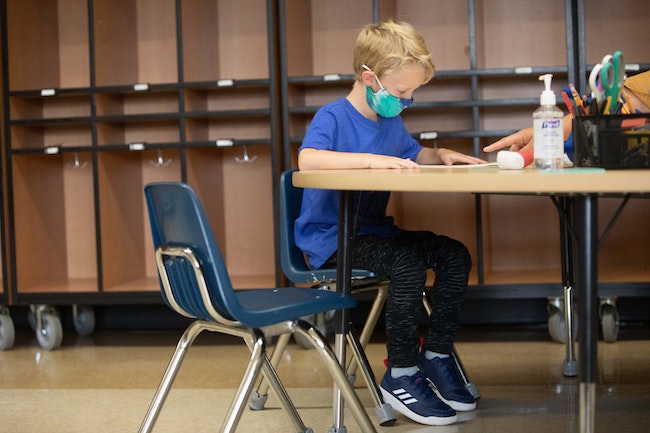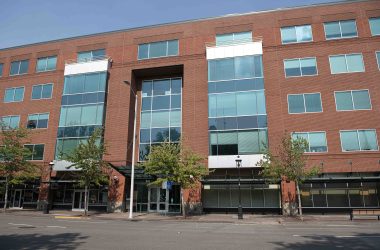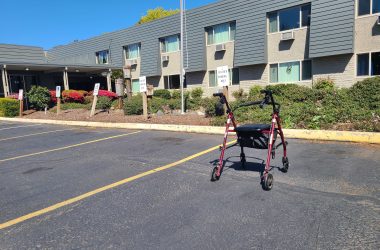 James Gough, an incoming kindergartner at Kalapuya Elementary School, works on an assessment test to gauge his alphabet comprehension on Thursday, September 17. (Amanda Loman/Salem Reporter)
James Gough, an incoming kindergartner at Kalapuya Elementary School, works on an assessment test to gauge his alphabet comprehension on Thursday, September 17. (Amanda Loman/Salem Reporter)
Christy Perry wants to get Salem’s kids back in schools in 2021.
But the surprise announcement, two days before Christmas, that Gov. Kate Brown would allow local school districts to make their own decisions about reopening after winter break still comes with far more questions than answers for the superintendent of the state’s second-largest district.
“Kids need to see each other and we need to see kids. That could be the greatest gift of 2021 if we can pull it off safely,” Perry said in an interview.
The governor’s decision left a mix of emotions around the state.
Parents who have been pushing for months for the state to loosen restrictions cheered the announcement, with some raising concerns districts wouldn’t act fast enough to reopen.
Some school leaders, including Perry, were cautiously optimistic about finding a way to get the school doors open.
Teacher unions objected, saying the change would create a chaotic patchwork of decisions around the state and add stress and uncertainty to winter break.
Perry knows several things for sure about her own schools. Students won’t be back before Feb. 8, the beginning of the district’s second semester, she said. District administrators will start planning next week, but families shouldn’t expect to hear about plans until January, she said.
Any change to resume classes will require weeks of planning to coordinate bus and classroom schedules so students are kept in small groups that don’t overlap during the day – one of the many health guidelines schools still will be required to follow.
Middle and high schools will be more challenging because of the large number of students enrolled, and the difficulties of keeping students separated from one another when they take multiple classes with different teachers, Perry said.
While some smaller and medium-sized districts in the state have reopened schools, Oregon doesn’t yet have a template for resuming classes in a building with 2,000 students – the size of many Salem high schools.
School in Salem won’t fully resume without an agreement with the district’s two employee unions, which will likely cover how safety protocols are enforced, which employees are required to work in-person and how classes will be staffed if schools offer hybrid schedules where some classes remain online.
“We have strong relationships to do that. We’d been working before the holidays to really tighten up our safety procedures,” Perry said.
Changes will be gradual too, Perry said. Her priority is first getting back the district’s youngest students, kindergarten through third grade.
“I don’t think we can flip a switch and one day we switch from (comprehensive distance learning) to in-person K-12,” she said.
Families who want to opt out of in-person school had the option to enroll in EDGE, a new all-online program the district created this year. That program now has about 6,000 students, Perry said.
Perry said that program will continue for students who want to stay online if local schools reopen. The chance for students to transfer into or out of that program recently closed, and Perry said district leaders will consider reopening transfers so families once they have clearer plans for returning kids to schools.
Most of Oregon’s schools have been operating online since March, when Brown ordered them to close. Over the summer, Brown took a top-down approach, issuing statewide rules saying schools in most cases had to operate entirely online if Covid cases in the surrounding county were too prevalent. That effectively forbid in-person classes for students in most of the state’s largest districts, including Salem-Keizer.
As the 2020-21 school year started, Oregon was an outlier among U.S. states, a majority of which put forward health guidelines and metrics but ultimately let school boards and county public health agencies decide whether to open for classes.
Brown’s shift to more local control came with a call to get as many students back into classrooms by Feb. 15, particularly for elementary school.
Districts will still have to follow a host of state-mandated safety guidelines, including requiring masks and spacing students out in classrooms.
Colt Gill, state schools chief, said those health guidelines will be key as Oregon districts consider expanding operations.
Many schools around Oregon have conducted brief in-person classes for students who particularly struggled with online school, even as buildings remained closed to the general student body. And some smaller Oregon districts have reopened for regular classes under the existing rules.
Weekly reports from Oregon Health Authority list schools where any student, employee or volunteer who was in the building tested positive for Covid, but don’t necessarily indicate the virus spread among people at the school. Since those reports began in the fall, dozens of schools around Oregon have recorded cases of Covid, almost all with fewer than five people confirmed to have the virus in one building.
Gill said when schools follow the health protocols intended to protect students and staff from the virus, “we’re seeing very little transmission at the school site. So that’s really, critically important,” he said.
Still, he said the local spread of Covid should remain an important factor in district decisions. That’s in part because a case of Covid at a school means sending kids and teachers at least in a particular close home to quarantine, adding disruption and uncertainty to the school year.
Brown asked state agencies to review those guidelines, as well as the mandatory safety protocols schools, and provide updated guidance by Jan. 19.
Under the existing metrics, Marion County has recorded three times the rate of new Covid cases that would allow schools to reopen. Even if the state recommendation changes in mid-
January, Perry said keeping an eye on that number will be important as the district gathers feedback on when and how to reopen.
The Salem area’s high Covid rates are a concern for the teachers union.
“To rush back into a public school, all student experience before we have systems in place to ensure everyone’s safety … we’re very concerned about what that might look like,” said Mindy Merrit, president of the Salem Keizer Education Association.
The union was negotiating with district leaders over holding more in-person classes for struggling students beginning in January. Merritt said teachers are committed to finding better ways to help kids who are struggling online, but she said fully reopening before a vaccine is widely available to teachers doesn’t make sense.
“Our members, educators, teachers love what they do and it shouldn’t come to making a life-or-death decision,” Merritt said.
Gill said state emergency relief funds, approved by the Legislature in a Dec. 21 special session, and federal aid to schools included in the relief package Congress passed this week, will help Oregon kids and educators stay safe. Those millions also could be used for the expanded summer school and recovery programs many kids are likely to need following nearly a year of online school.
Brown has asked $55 million be set aside for schools. Gill said he expects further direction from the Legislature on how that money should be spent, but expects districts will need help getting kids caught up academically, buying protective equipment like face masks and providing services like counseling for kids struggling because of the pandemic and social isolation over the past year.
Contact reporter Rachel Alexander: [email protected] or 503-575-1241.
RELATED COVERAGE:
Path for more Oregon kids in the classroom opens in 2021 as governor makes reopening decisions local
WE GET SALEM THE FACTS. Covering your community with care and depth. Salem Reporter – fair, accurate, independent. Subscribe and support our local service.

Rachel Alexander is Salem Reporter’s managing editor. She joined Salem Reporter when it was founded in 2018 and covers city news, education, nonprofits and a little bit of everything else. She’s been a journalist in Oregon and Washington for a decade. Outside of work, she’s a skater and board member with Salem’s Cherry City Roller Derby and can often be found with her nose buried in a book.









